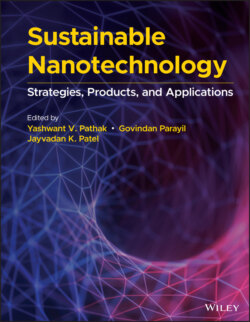Читать книгу Sustainable Nanotechnology - Группа авторов - Страница 44
2.1 Introduction
ОглавлениеAdvances in nanotechnology are generating novel nanomaterials (NMs) with extraordinary characteristics that can enrich and enhance the applicability of NMs in various sectors. As new uses are being explored on a daily basis in various diversified areas such as medicine, agriculture, automotive, and energy, it poses numerous challenges to environmental sustainability [1]. Application of NMs are improving energy conservation and increasing efficiency, productivity and profits of industrial and health sectors with lower environmental impact [2]. Using NMs in current technology can improve economic and environmental aspects with various applications. Simultaneously, it is accepted that the use of NMs increases the various challenges in human safety and regulations in various countries [3].
In 2011, a group of researchers, students, and government staff from a multidisciplinary area came together to check the effect of science and engineering on developing a new path with sustainable future. This panel of scientists had done research on nanotechnology and correlated it to various aspects of sustainability such as society, environment, and economy [4]. The Sustainable Nanotechnology Organization (SNO) has come into existence with the aim to support the advances in sustainable nanotechnology. It also promotes the progression of scientific work in the field of nanotechnology for safety, environment, and health. However, every developing technology is required to be balanced between the benefits for human and its undesired effects on environment and life [5].
As advances in nanotechnology continue, the research is progressing on many issues regarding sustainability for next decades. Recent advances in nanotechnology report worldwide challenges in various applications such as purification of water, management of greenhouse effect, and manufacturing using green chemistry [6]. Because of the significant physicochemical properties of NMs, it gives us more effective solution for sustainable technologies. In comparison with bulk materials, NMs have effective larger surface area. The synthesis of NMs with incorporation of functional group can increase their affinity toward a given compound with improved efficiency. NMs can also give us an opportunity to enhance them with improved optical, magnetic, and catalytic properties [7]. For instance, in the case of semiconductor quantum dots, the variation in fluorescence emission capacity depends strongly on the difference in particle size. Nanoscale materials have different physicochemical and biological properties, which meet many growing needs of society. By exploring the novel development of NMs with new properties, it can be possible to enhance the performance of materials significantly, in terms of achievement of more product performance using less material [8, 9]. Development of NMs using required approach having ecofriendly characteristics is need of todays industries like textiles, paints and biomedical [10]. The available methods used for preparation of nanostructured materials are ultrasonication, reverse‐phase micelle, microwave assisted techniques, and deposition of vapour by chemical and physical means [11]. Nano metal oxides such as Al2O3, TiO2, and SiO2 have been efficiently obtained from the nature and is one of the best examples of such techniques [12]. Today, the available solar cells having effectiveness of 10–25% are made up of silicon [13]. The cost of a solar cell can be reduced by improving its efficiency, which makes it more economically competitive [14]. By using nanostructured surface for reflectivity in solar cell devices, the antireflection ability may be enhanced effectively using NMs having diameter less than the wavelength of incident light. To increase the usage of solar light, antireflection NMs are patterned with active components, and thus the cost can be reduced [15]. Also, light‐capturing capacity can be additionally increased by light trapping, so it requires less amount of material to absorb solar light, and the cost can be reduced [16].
NMs can be used to solve various challenges in the environment, e.g. it can be used to restore the polluted soil with cleaning of water and air, and it also can reduce the impact of chemical manufacturing using nanoscale catalyst [17, 18]. Therefore, various opportunities are offered by nanotechnology in manufacturing novel NMs that improves living conditions using advanced techniques in various fields.
Despite significant development and increased utilization in many marketed products, NMs and their technology are still facing challenges in energy, environment, health, and safety (EHS). One of the principal challenges that comes up with nanotechnology is its influence on environment and its toxicity to humans. The cause for toxicity in humans is due to the availability of NMs with different properties that might lead to adverse drug reaction. NMs undertake biodegradation in their working atmosphere. This might lead to intracellular changes and gene modifications. If the gene alteration is undesirable, then it might prove hazardous for human beings. NMs are not always environmentally safe. They sometimes enter the ecology's food chain and cause changes. So, it is necessary first to understand the life cycle of NMs with their activity in the environment. It is necessary to focus on the size, structure, and reactivity of NMs in environmental systems [19].
